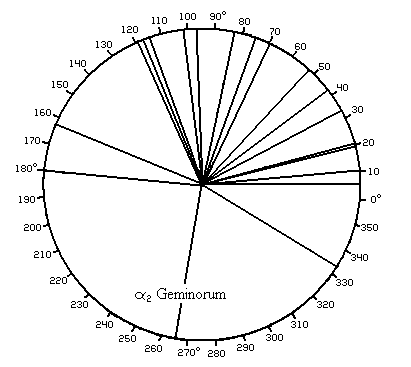Spectroscopic Binaries With Apparent Peculiar OrbitsAfter J. Miller Barr (1)
Installed on 30 Apr 2010. Latest update 16 Jun 2016. This page shows a graph of computed longitudes of periastron based on a truncated version of
J. Miller Barr's (1908) table of spectroscopic binaries(1). Eight Cepheid variables (which are currently
considered to be pulsators) and three binaries for which the eccentricity and average orbit speed were not
available, have been removed from
the table.

The radial lines represent the values of ω, i.e., the computed longitude of periastron, for nineteen spectroscopic binaries. See accompanying table. |
Double-lined spectroscopic binaries, which have now been visually resolved,(2) are noted by pound signs.
======================================================================================
STAR P e ω K Reference
--------------------------------------------------------------------------------------
d Degrees km.
[#] β Arietis 107.0 0.88 19.7 32.6 Astroph. Jour., 25, 320, 1907
Capella 104.022 0.016 117.3 25.76 " " 14, 263, 1901
η Orionis 7.9896 0.016 42 16' 144.75 " " 17, 68, 1903
δ Orionis 5.7325 0.103 33 19 100.85 " " 19, 268, 1904
ζ Tauri 138. 0.180 9 45 14.95 " " 22, 115, 1905
α2 Geminorum 9.2188 0.503 265.35 13.56 " " 23, 351, 1906
κ Cancri 6.393 0.149 162 16 67.8 " " 25, 315, 1907
V Carinae 6.744 0.18 115.84 21.5 " " 26, 268, 1907
κ Velorum 116.65 0.19 96.23 46.5 " " 26, 271, 1907
η Virginis 71.9 0.254 180 0 26.8 " " 26, 282, 1907
[#] Mizar 20.6 0.502 101.3 142. " " 13, 324, 1901
α Draconis 51.38 0.43 19. 48. ± Jour. R.A.S.C., 1, 237, 1907
μ Sagittarii 180.2 0.441 74 43 64.5 Astroph. Jour., 26, 157, 1907
[#] χ Draconis 281.8 0.423 119.0 18.15 " " 11, 131, 1900
β Lyrae 12.908 0.07 83.4 181.05 " " 6, 328, 1897
η Aquilae 7.176 0.489 68.91 20.59 " " 9, 59, 1899
[#] θ Aquilae 17.17 0.725 20. 52. ± Jour. R.A.S.C., 1, 357, 1907
η Pegasi 818.0 0.155 5.61 14.20 Astroph. Jour., 14, 202, 1901
λ Andromedae 20.546 0.086 301.0 7.07 " " 24, 345, 1906
[The next to last reference had a typo. The page number was given as 20.]
|
References(2) Pourbaix, D., Resolved double-lined spectrographic binaries: A neglected source of hypothesis-free parallaxes and stellar masses, Astronomy & Astrophysics Supplement Series, 145, 215 (2000) - NADS |
Send comments/questions to Robert Fritzius at
fritzius@bellsouth.net

Top